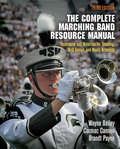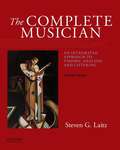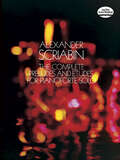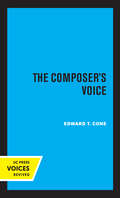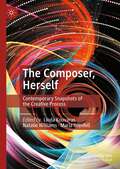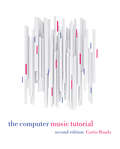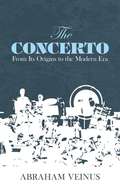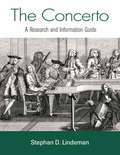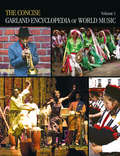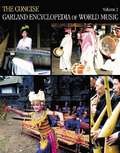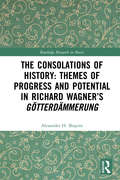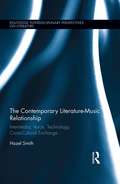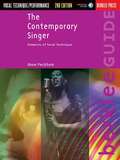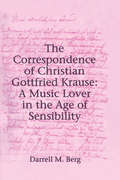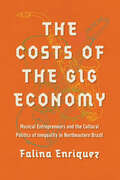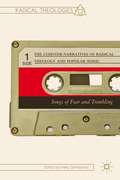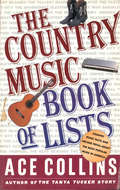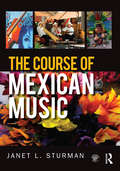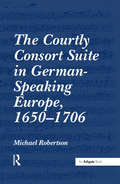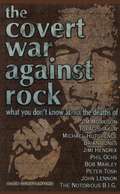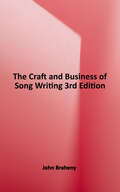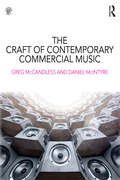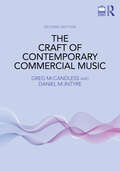- Table View
- List View
The Complete Marching Band Resource Manual: Techniques and Materials for Teaching, Drill Design, and Music Arranging
by Wayne Bailey Cormac Cannon Brandt PayneThe Complete Marching Band Resource Manual is the definitive guide to the intricate art of directing college and high school marching bands. Supplemented with musical arrangements, warm-up exercises, and over a hundred drill charts, this manual presents both the fundamentals and the advanced techniques that are essential for successful marching band leadership. The materials in this volume cover every stage of musical direction and instruction, from selecting music and choreographing movements to improving student memorization and endurance to the creation of striking visual configurations through uniform and auxiliary units.Now in its third edition, The Complete Marching Band Resource Manual has been thoroughly updated to reflect new standards for drill design, charting, and musical arrangement. Offering a fresh approach to the essentials of good marching band design, this comprehensive resource shows both veteran and novice band directors how to prepare students to perform seamless and sophisticated musical formations.
The Complete Musician: An Integrated Approach To Theory, Analysis And Listening
by Steven G. Laitz Ian SewellBeginning with music fundamentals, The Complete Musician covers all the topics necessary for a thorough understanding of undergraduate music theory by focusing on music in context. <P><P>Rather than rote learning of concepts and memorizing terms, The Complete Musician emphasizes how theory informs the work of performers. Composers respond not only to their instincts, experiences, and training in every work they write; they also follow certain ideals and models when appropriate, and modify them to fit their own personal vision. <P><P>Theory is not a "theoretical" activity; it is a living one that responds to how music is composed and performed. Understanding how theory intersects with composition and performance is key to seeing its relevance to students' wider musical lives. The Complete Musician makes this connection.
The Complete Preludes and Etudes for Pianoforte Solo (Dover Classical Piano Music)
by Alexander ScriabinAlexander Nikolayevitch Scriabin (1872-1915), Russian composer and pianist, is best known for his perfectly spun miniatures where his novel harmonic and pianistic ideas were most brilliantly worked out. This volume in Dover's continuing series of musical scores presents the best of Scriabin's works, his complete etudes and preludes for the solo piano. There are the Chopinesque works from his early period, including the 12 etudes from Op. 8 and the 24 Preludes, Op. 11. The works of the middle period, when he began working out his new harmonies based on a series of fourths, include the outstanding sets of Preludes, Opp. 33 and 48, and the Etudes, Op. 42. The 5 Preludes, Op. 74, and the Etudes, Op. 65, from the final period reveal perhaps most about his joyous ecstasy and languid contemplation, moods which no other composer could express to such a degree. There are also the preludes and etudes from Opp. 2, 9, 13, 15, 16, 17, 22, 27, 31, 35, 37, 39, 45, 49, 51, 59, and 67, each containing miniatures working out some subtle harmonic, rhythmic, or melodic idea with a perfect pianistic sense of writing. This book has been especially designed as a playing edition - the noteheads are large and easily readable at the piano, and the margins and spaces between staves are adequate for written notes, fingerings, and turnovers. It is also most useful for analysis, or simply for following along with the actual music.
The Composer's Voice (Ernest Bloch Lectures #3)
by Edward T. ConeMusic, we are often told, is a language. But if music is a language, then who is speaking? The Composer's Voice tries to answer this obvious but infrequently raised question. In so doing, it puts forward a dramatistic theory of musical expression, based on the view that every composition is a symbolic utterance involving a fundamental act of impersonation. The voice we hear is not that of the composer himself, but of a persona--a musical projection of his consciousness that experiences and communicates the events of the composition. Developing his argument by reference to numerous examples ina wide variety of styles, Mr. Cone moves from song and opera through program music to absolute instrumental music. In particular, he discusses the implications of his theory for performance. According to the dramatistic view, not only every singer but every instrumentalist as well becomes a kind of actor, assuming a role that functions both autonomously and as a component of the total musical persona. In his analysis of the problems inherent in this dual nature of the performer's job, Mr. Cone offers guidance that will prove of practical value to every performing musician. He has much to say to the listener as well. He recommends an imaginative participation in the component roles of musical work, leading to a sense of identification with the persona itself, as the path to complete musical understanding. And this approach is shown to be relevant to a number of specialized kids of listening as well--those applicable to analysis, historical scholarship, and criticism. The dance, too, is shown to depend on similar concepts. Although The Composer's Voice involves an investigation of how music functions as a form of communication, it is not primarily concerned with determine, or interpreting, the "content" of the message. A final chapter, however, puts forward a tentative explanation of musical "meaning" based on an interpretation of the art as a coalescence of symbolic utterance and symbolic gesture. While not essential to the main lines of the argument, it suggests interesting possibilities for further development of the dramatistic theory. This title is part of UC Press's Voices Revived program, which commemorates University of California Press's mission to seek out and cultivate the brightest minds and give them voice, reach, and impact. Drawing on a backlist dating to 1893, Voices Revived makes high-quality, peer-reviewed scholarship accessible once again using print-on-demand technology. This title was originally published in 1974.
The Composer, Herself: Contemporary Snapshots of the Creative Process
by Natalie Williams Linda Kouvaras Maria GrenfellThis edited volume presents 27 original essays by living composers from all around the globe, reflecting on the creation of their music. Coterminous to the recent worldwide resurgence in feminist focus, the distinctive feature of this collection is the “snapshots” of creative processes and conceptualizing on the part of women who write music, writing in the present day, from prominent early-career composers to major figures, from a range of ethnic backgrounds in the contemporary music field. The chapters step into the juncture point at which feminism finds itself: as binary conceptions of gender are being dissolved, with critiques of the attendant gender-based historical generalizations of composers, and with the growing awareness of the rightful place of First Nations' cultural voices, the contributors explore what, actually, is being composed by women, and what they think about their world. The needs that this book serves are acutely felt: despite recent social gains, and sector initiatives and programs encouraging and presenting the work of women who compose music, their works are yet to receive commensurate exposure with that of their male counterparts. In its multi-pronged, direct response to this dire situation, this vibrant volume highlights established as well as emerging women composers on the international stage; reveals myriad issues around feminism, as broadly conceived; and gives insights, from the composers' own voices, on the inner workings of their composition process.The volume thus presents a contemporary moment in time across the generations and within developments in musical composition. With its unique insights, this book is essential for academics and practitioners interested in the illuminations of the current working landscape for creative women.
The Computer Music Tutorial, second edition
by Curtis RoadsExpanded, updated, and fully revised—the definitive introduction to electronic music is ready for new generations of students.Essential and state-of-the-art, The Computer Music Tutorial, second edition is a singular text that introduces computer and electronic music, explains its motivations, and puts topics into context. Curtis Roads&’s step-by-step presentation orients musicians, engineers, scientists, and anyone else new to computer and electronic music.The new edition continues to be the definitive tutorial on all aspects of computer music, including digital audio, signal processing, musical input devices, performance software, editing systems, algorithmic composition, MIDI, and psychoacoustics, but the second edition also reflects the enormous growth of the field since the book&’s original publication in 1996. New chapters cover up-to-date topics like virtual analog, pulsar synthesis, concatenative synthesis, spectrum analysis by atomic decomposition, Open Sound Control, spectrum editors, and instrument and patch editors. Exhaustively referenced and cross-referenced, the second edition adds hundreds of new figures and references to the original charts, diagrams, screen images, and photographs in order to explain basic concepts and terms.FeaturesNew chapters: virtual analog, pulsar synthesis, concatenative synthesis, spectrum analysis by atomic decomposition, Open Sound Control, spectrum editors, instrument and patch editors, and an appendix on machine learningTwo thousand references support the book&’s descriptions and point readers to further studyMathematical notation and program code examples used only when necessaryTwenty-five years of classroom, seminar, and workshop use inform the pace and level of the material
The Concerto
by Abraham VeinusThe long, colorful history of the concerto unfolds, from its origins in the 16th and 17th centuries to the present day.
The Concerto: A Research and Information Guide (Routledge Music Bibliographies #Vol. N28)
by Stephan D. LindemanTwelve-tone and serial music were dominant forms of composition following World War II and remained so at least through the mid-1970s. In 1961, Ann Phillips Basart published the pioneering bibliographic work in the field.
The Concise Garland Encyclopedia of World Music, Volume 1
by Garland Encyclopedia of World MusicThe Concise Garland Encyclopedia of World Music comprises two volumes, and can only be purchased as the two-volume set. To purchase the set please go to: http://www.routledge.com/9780415972932
The Concise Garland Encyclopedia of World Music, Volume 2
by Garland Encyclopedia of World MusicThe Concise Garland Encyclopedia of World Music comprises two volumes, and can only be purchased as the two-volume set. To purchase the set please go to: http://www.routledge.com/9780415972932
The Concise Oxford Dictionary of Music (5th edition)
by Michael Kennedy Joyce Bourne KennedyDerived from the classic Oxford Dictionary of Music, this is the most authoritative dictionary of music available in paperback. It is a rich mine of information for lovers of music of all periods and styles. Fully revised and updated, the 5th edition of this established reference work contains over 200 new entries, including information on approximately 150 new performers. Written by Michael Kennedy, a renowned authority on classical music, the dictionary includes over 14,000 entries on terms from "allegro" to "zingaro," and on works from "Aida "to "Tosca," as well as instruments and their history, composers, librettists, musicians, singers, and orchestras. It also boasts comprehensive works lists for major composers. It remains the essential reference for music students and teachers, and fascinating reading for all other music enthusiasts.
The Consolations of History: Themes of Progress and Potential in Richard Wagner’s Gotterdammerung (Routledge Research in Music)
by Alexander H. ShapiroIn this book on Richard Wagner’s compelling but enigmatic masterpiece Götterdämmerung, the final opera of his monumental Ring tetralogy, Alexander H. Shapiro advances an ambitious new interpretation which uncovers intriguing new facets to the work’s profound insights into the human condition. By taking a fresh look at the philosophical and historical influences on Wagner, and critically reevaluating the composer’s intellectual worldview as revealed in his own prose works, letters, and diary entries, the book challenges a number of conventional views that continue to impede a clear understanding of this work’s meaning. The book argues that Götterdämmerung, and hence the Ring as a whole, achieves coherence when interpreted in terms of contemporary nineteenth-century theories of progress, and, in particular, G.W.F. Hegel’s philosophies of mind and history. A central target of the book is the article of faith that has come to dominate Wagner scholarship over the years – that Wagner’s encounter in 1854 with Arthur Schopenhauer’s philosophy conclusively altered the final message of the Ring from one of historical optimism to existential pessimism. The author contends that Schopenhauer’s uncompromising denigration of the will and denial of the possibility for human progress find no place in the written text of the Ring or in a plausible reading of the final musical setting. In its place, the author discovers in the famous Immolation Scene a celebration of mankind’s inexhaustible capacity for self-improvement and progress. The author makes the further compelling case that this message of progress is communicated not through Siegfried, the traditional male hero of the drama, but through Brünnhilde, the warrior goddess who becomes a mortal woman. In her role as a battle-tested world-historical prophet she is the true revolutionary change agent of Wagner’s opera who has the strength and vision to comprehend and thereby shape human history. This highly lucid and accessible study is aimed not only at scholars and researchers in the fields of opera studies, music and philosophy, and music history, but also Wagner enthusiasts, and readers and students interested in the history and philosophy of the nineteenth century.
The Contemporary Literature-Music Relationship: Intermedia, Voice, Technology, Cross-Cultural Exchange (Routledge Interdisciplinary Perspectives on Literature)
by Hazel SmithThis book explores the relationship between words and music in contemporary texts, examining, in particular, the way that new technologies are changing the literature-music relationship. It brings an eclectic and novel range of interdisciplinary theories to the area of musico-literary studies, drawing from the fields of semiotics, disability studies, musicology, psychoanalysis, music psychology, emotion and affect theory, new media, cosmopolitanism, globalization, ethnicity and biraciality. Chapters range from critical analyses of the representation of music and the musical profession in contemporary novels to examination of the forms and cultural meanings of contemporary intermedia and multimedia works. The book argues that conjunctions between words and music create emergent structures and meanings that can facilitate culturally transgressive and boundary- interrogating effects. In particular, it conceptualises ways in which word-music relationships can facilitate cross-cultural exchange as musico-literary miscegenation, using interracial sexual relationships as a metaphor. Smith also inspects the dynamics of improvisation and composition, and the different ways they intersect with performance. Furthermore, the book explores the huge changes that computer-based real-time algorithmic text and music generation are making to the literature-music nexus. This volume provides fascinating insight into the relationship between literature and music, and will be of interest to those fields as well as New Media and Performance Studies.
The Contemporary Singer: Elements of Vocal Technique (Second Edition)
by Anne PeckhamThe second edition of this bestselling, comprehensive guide contains improved vocal workouts and additional topics, including performance anxiety and healthy singing. Topics covered include getting started, posture, belting and diction, maintaining vocal health, microphone technique, and much more.
The Correspondence of Christian Gottfried Krause: A Music Lover in the Age of Sensibility
by Darrell M. BergThe fascinating correspondence of the Berlin lawyer and musician Christian Gottfried Krause is an important document reflecting the trends and developments in aesthetics, music theory and music making in the Prussian capital during the reign of Frederick the Great. Krause's letters shed light on the rise of a bourgeois music culture, which during h
The Costs of the Gig Economy: Musical Entrepreneurs and the Cultural Politics of Inequality in Northeastern Brazil
by Falina EnriquezInstitutions in Recife, Brazil, have restructured subsidies in favor of encouraging musicians to become more entrepreneurial. Falina Enriquez explores how contemporary and traditional musicians in the fabled musical city have negotiated these intensified neoliberal cultural policies and economic uncertainties. Drawing on years of fieldwork, Enriquez shows how forcing artists to adopt “neutral” market solutions reinforces, and generates, overlapping racial and class-based inequalities. Lacking the social and financial resources of their middle-class peers, working-class musicians find it difficult to uphold institutional goals of connecting the city’s cultural roots to global markets and consumers. Enriquez also links the artists’ situation to that of cultural and creative workers around the world. As she shows, musical sponsorship in Recife and the contemporary gig economy elsewhere employ processes that, far from being neutral, uphold governmental and corporate ideologies that produce social stratification. Rich and vibrant, The Costs of the Gig Economy offers a rare English-language portrait of the changing musical culture in Recife.
The Counter-Narratives of Radical Theology and Popular Music
by Mike GrimshawIn this unique collection, theologians born and formed during the Cold War offer their insights and perspectives on theological relationships with such musical artists and groups as Joy Division, U2, Nick Cave, and John Coltrane. These essays demonstrate that one's personal music preferences can inform and influence professional interests.
The Country Music Book of Lists
by Ace CollinsMore than just charts, star bios, and boring listings, "The Country Music Book of Lists" is the perfect gift or pop reference guide for trivia fans, filled with humor, insight, and "down home fun".
The Course of Mexican Music
by Janet SturmanThe Course of Mexican Music provides students with a cohesive introductory understanding of the scope and influence of Mexican music. The textbook highlights individual musical examples as a means of exploring the processes of selection that led to specific musical styles in different times and places, with a supporting companion website with audio and video tracks helping to reinforce readers' understanding of key concepts. The aim is for students to learn an exemplary body of music as a window for understanding Mexican music, history and culture in a manner that reveals its importance well beyond the borders of that nation.
The Courtly Consort Suite in German-Speaking Europe, 1650-1706
by Michael RobertsonDance music at the courts of seventeenth-century Germany is a genre that is still largely unknown. Dr Michael Robertson sets out to redress the balance and study the ensemble dance suites that were played at the German courts between the end of the Thirty Years War and the early years of the eighteenth century. At many German courts during this time, it was fashionable to emulate everything that was French. As part of this process, German musicians visited Paris throughout the second half of the seventeenth century, and brought French courtly music back with them on their return. For the last two decades of the century, this meant the works of Jean-Baptiste Lully, and his music and its influence spread rapidly through the courts of Europe. Extracts from Lully's dramatic stage works were circulated in both published editions and manuscript. These extracts are considered in some detail, especially in terms of their relationship to the suite. The nobility also played their part in this process: French musicians and German players with specialist knowledge were often hired to coach their German colleagues in the art of playing in the French manner, the franz‘sischer Art. The book examines the dissemination of dance music, instrumentation and performance practice, and the differences between the French and Italian styles. It also studies the courtly suites before the advent of Lullism and the differences between the suites of court composers and town musicians. With the possible exception of Georg Muffat's two Florilegium collections of suites, much of the dance music of the German Lullists is largely unknown; court composers such as Cousser, Erlebach, Johann Fischer and Johann Caspar Ferdinand Fischer all wrote fine collections of ensemble suites, and these are examined in detail. Examples from these suites, some published for the first time, are given throughout the book in order to demonstrate the music's quality and show that its neglect is completely unjustifi
The Covert War Against Rock
by Alex ConstantineThe connections between government, organized crime, and the music industry are examined, offering compelling evidence that there may be more to the deaths of important popular musicians than has been commonly told.
The Craft And Business Of Songwriting: A Practical Guide To Creating And Marketing Artistically And Commercially Successful Songs
by John BrahenyThe essential guide for success in songwriting In this comprehensively updated 3rd Edition, John Braheny teaches you the craft of songwriting and then goes behind the scenes of the music business to unearth insider secrets that will make your songs stand out. You'll find exercises and anecdotes to help you: Develop a "songwriter's consciousness" for picking out original ideas Collaborate effectively with co-writers Break into songwriting for film & TV, children's music, and commercials Use the internet to best advantage for pitching songs, networking, and publicity Understand the business of demos and song contracts Braheny also brings you up to date with ongoing changes in online digital song distribution, podcasting, song-pitching services, home recording technology, production music libraries, and web hosting services. It's everything you need to know to make your mark on the world of music!
The Craft and Business of Song writing, 3rd Edition
by John BrahenyThe essential guide for success in songwriting In this comprehensively updated 3rd Edition, John Braheny teaches you the craft of songwriting and then goes behind the scenes of the music business to unearth insider secrets that will make your songs stand out. You'll find exercises and anecdotes to help you: - Develop a "songwriter's consciousness" for picking out original ideas - Collaborate effectively with co-writers - Break into songwriting for film & TV, children's music, and commercials - Use the internet to best advantage for pitching songs, networking, and publicity - Understand the business of demos and song contracts Braheny also brings you up to date with ongoing changes in online digital song distribution, podcasting, song-pitching services, home recording technology, production music libraries, and web hosting services. It's everything you need to know to make your mark on the music world!
The Craft of Contemporary Commercial Music
by Greg McCandless Daniel McIntyreIn the contemporary world, the role of the commercial composer has grown to include a wide range of new responsibilities. Modern composers not only write music, but also often need to perform, record, and market their own works. The Craft of Contemporary Commercial Music prepares today’s music students for their careers by teaching them to compose their own music, produce it professionally, and sell it successfully. The textbook integrates three areas of concentration—music theory and composition, audio engineering, and music business—allowing students to understand and practice how to successfully navigate each stage of a score’s life cycle from concept to contract. Students will learn how to: Translate musical ideas into scores utilizing music theory and composition techniques Transform scores into professional audio through the production stages of tracking, sequencing, editing, mixing, mastering, and bouncing Market works to prospective clients The textbook assumes no prior knowledge of music theory or audio topics, and its modular organization allows instructors to use the book flexibly. Exercises at the end of each chapter provide practice with key skills, and a companion website supports the book with video walkthroughs, streaming audio, a glossary, and printable exercise pages. Combining a grounding in music notation and theory concepts with a foundation in essential technologies, The Craft of Contemporary Commercial Music offers an innovative approach that addresses the needs of students preparing for music careers.
The Craft of Contemporary Commercial Music
by Greg McCandless Daniel McIntyreThe role of the commercial composer has grown to include a wide range of new responsibilities. Modern composers not only write music, but often, they also need to record, and market their own works. The Craft of Contemporary Commercial Music prepares today’s music students for their careers by teaching them to compose their own music, produce it professionally, and sell it successfully. The textbook integrates three areas of concentration—music theory and composition, audio engineering, and music business—allowing students to understand and practice how to successfully navigate each stage of a score’s life cycle from concept to contract. Students will learn how to: Translate musical ideas into scores utilizing music theory and composition techniques Transform scores into professional audio through the production stages of tracking, sequencing, editing, mixing, mastering, and bouncing Market works to prospective clients The textbook assumes no prior knowledge of music theory or audio topics, and its modular organization allows instructors to use the book flexibly. Exercises at the end of each chapter provide practice with key skills, and online Instructor and Student Resources support the book with video walkthroughs, streaming audio, a glossary, and printable exercise pages. This second edition includes: Enhanced and new images throughout the book Updated technology examples, including greater integration of Ableton Live Discussions of industry-standard equipment, featuring companies such as Universal Audio, FabFilter, and iZotope More focus on popular music examples throughout the book, particularly in the context of music theory An expanded section on the music business, with new information on contracts, royalties, and digital play-tracking services Exercise answer keys for instructors, new video walkthroughs, and more online resources available at routledgelearning.com/cccm Combining a grounding in music notation and theory concepts with a foundation in essential technologies, The Craft of Contemporary Commercial Music offers an innovative approach that addresses the needs of students preparing for music careers.
